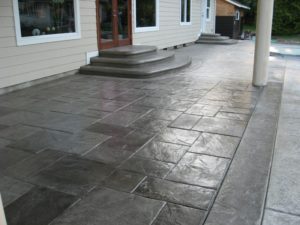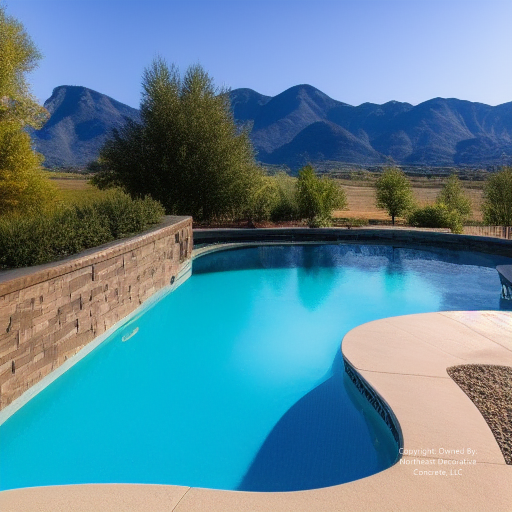
We service all of New Hampshire (NH) , Massachusetts (MA) , and Maine (ME) with Decorative Concrete, Stamped Concrete, Epoxy Floor Coatings, and Garage Flooring. We have a large selection of colors and patterns! Give us a call for your next concrete project. We provide Free Estimates.
What Is Concrete and How Is It Made
Concrete is a composite construction material made of aggregate, cement and water. The aggregate is usually crushed stone or gravel, while the cement is usually Portland cement. Concrete can be used for both residential and commercial construction projects. It is popular because it is strong and durable, and it can be molded into a variety of shapes.

What Is Concrete?
Concrete is a composite material composed of coarse aggregate bonded together with a fluid cement that hardens over time. Concrete is usually used as a construction material, but can also be used for decorative purposes.
Concrete is a construction material that consists of cement, aggregates, and water. The cement binds the aggregates together and the water allows it to cure and harden. Concrete can be used in a variety of applications such as foundations, walls, floors, and pavements. It is strong, durable, and relatively inexpensive.
How Is Concrete Made?
Concrete is made by combining cement, water, sand, and gravel. The ingredients are mixed together to form a thick slurry that is poured into molds. After the concrete sets, it is smoothed and polished to form a hard surface.
To make concrete, you need some mandatory ingredients and then you can add optional ingredients to change the color or consistency. The mandatory ingredients are portland cement, water, and aggregates. The aggregates can be either natural or synthetic. Synthetic aggregates are usually made from recycled materials like plastic or glass. To make the concrete more durable, you can add a bonding agent like fly ash or slag. You can also add colorants, retarders, or accelerators to change the appearance or set time of the concrete.
How Long Has Concrete Been Around?
The history of concrete is a long and eventful one. It’s been used as a building material for thousands of years and is still one of the most popular construction materials today. So, how long has concrete been around? Let’s take a look.
The first known use of concrete was in ancient Egypt around 2600 BC. The Egyptians used it to build pyramids and other structures. Concrete was also used in China during the same period. In fact, the Great Wall of China was built with concrete bricks.
Concrete began to be used in Europe during the Roman Empire. The Romans were some of the first people to use it on a large scale for construction projects. They used it to build roads, bridges, and other structures.
Concrete continued to be used throughout the Middle Ages and into the Renaissance period.
Types of Concrete
Concrete has been used for centuries and is still one of the most popular construction materials. There are different types of concrete, each with its own advantages and disadvantages.
The two main types of concrete are plain concrete and reinforced concrete. Plain concrete is made up of cement, aggregate, and water. It is cheap and easy to produce, but it is not very strong or durable. Reinforced concrete is made up of the same ingredients as plain concrete, but steel bars are also added to increase strength and durability.
Another type of concrete is self-consolidating concrete (SCC). SCC is a low-viscosity mixture that flows easily under its own weight and does not require vibration to settle properly. This makes it ideal for use in applications where vibration could cause damage, such as in high-rise buildings or bridges.
Where Is Concrete Usually Made?
Concrete is one of the most commonly used building materials in the world. It is made by combining cement, water, and aggregate. The most common type of concrete is made with Portland cement. Concrete can also be made with other types of cement, such as slag cement or fly ash. Concrete can also be made with a variety of aggregates, including crushed stone, gravel, or recycled concrete.
Concrete is usually made at a central plant called a ready-mix plant. A ready-mix plant has a large tank called a mixer that combines the ingredients to make concrete. The concrete is then discharged from the mixer into trucks and delivered to the job site.
How Is Concrete Transported?
One of the most important elements in the construction process is the transportation of concrete. With the help of ready-mix trucks, concrete can be transported quickly and easily to the desired location. In order to ensure that the concrete arrives at its destination intact, there are a few things that need to be taken into consideration.
The first step is to properly mix the concrete. The ingredients need to be evenly combined in order to produce a consistent mixture. It’s also important to make sure that there is enough water in the mix, but not too much or it will cause problems during transport.
Once the concrete is ready, it needs to be loaded into the truck. This is usually done with a cement mixer, which ensures that the concrete is evenly distributed. The truck driver must take into account things like weight distribution and speed when driving so that the load remains stable.
Concrete FAQs
What is the difference between concrete and cement?
Cement is an ingredient in concrete. It is a powdered substance that, when mixed with water, sand, and gravel, forms a paste that binds the other ingredients together. Concrete is a mixture of cement, water, sand, and gravel that is poured into place and allowed to harden.
Concrete can be made more durable by adding small stones or crushed glass called “coarse aggregate.” Steel mesh or reinforcing bars can also be added to make the concrete more resistant to breaking under stress.
When was concrete first used?
The Romans were some of the first people to use concrete extensively. They built roads, bridges, and aqueducts using the material.
- How Strong Is Concrete
- What Are The Advantages Of Concrete
- How Long Will Concrete Last
- Can Concrete Be Poured In The Winter
- Which Concrete Is Best For Slabs
- Why Concrete Needs Reinforcement
Our Locations:
Nashua, NH
North Hampton, NH
Concord, NH

